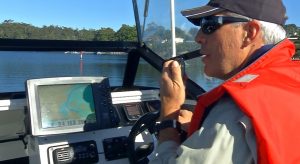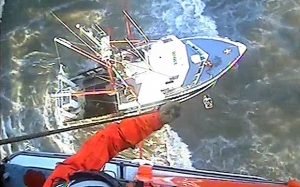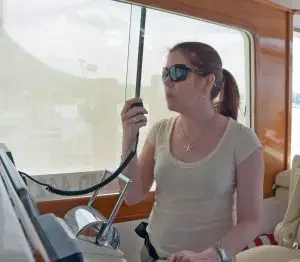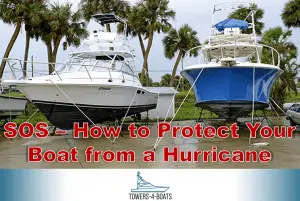Can I use my cellphone in place of a VHF radio
If you regularly take your boat out into open or secluded waters, then you’ve likely already discovered that communication can be a major problem without a very high frequency (VHF) radio. Whether it’s an emergency or just asking a fishing buddy where the action is, you need to have a reliable source of communication on your boat. Cellphones and VHF radios are your two main options, and in this article we’ll show you why it’s really not a choice at all.
Cell phones are a great way to stay connected to family and friends on land, and many boaters use them while on the water. If you need assistance, you won’t be able to reach other boaters on your phone, unless you have their telephone number. A VHF radio allows you to communicate with other boats and the Coast Guard. In the event of an emergency, you can get the help you need right away. Marine radios are also water-resistant with long battery lives which makes them more dependable than cell phones. Although cellphones are convenient, the hands down winner for marine communications is a VHF radio.
Communication Matters When You’re Boating
 Many boaters take their smartphones and tablets with them on their boating adventures. While these are useful devices, using them as your only source of communication isn’t prudent. In fact, it can be a life or death decision if you face a boating emergency.
Many boaters take their smartphones and tablets with them on their boating adventures. While these are useful devices, using them as your only source of communication isn’t prudent. In fact, it can be a life or death decision if you face a boating emergency.
If you’ve stayed close to shore, boated in waterways close to an urban setting, or are new to boating, then you might not realize that your cellphone and smart devices have limitations that make them unreliable in marine conditions. On the other hand, if you’ve had your device slip out of your pocket or hand into the water while you’re boating, then you’re likely just shaking your head, right?
As a direct-dial device that requires a signal that can easily be blocked or unavailable, cellphones can’t be relied upon in a boating emergency. Your cellphone or smart device losing charge on land is one thing, but imagine looking around at nothing but water, a sinking boat, and a dead battery on the only source of communication you have to gain help.
A VHF radio adds a different dimension to communication within the marine environment. Depending on the height of the antenna and power output, a VHF radio’s signal can reach vessels and shore stations from fairly long distances. Fixed-mounted VHF radios place a large multi-function display directly in front of the driver, which also frees your hands up from distracting driving tasks that can cause an emergency boating situation.
The Pros and Cons Of Smart Devices in the Marine World
- Call a Buddy, Not a Stranger
Given you have their numbers and are within range of a cell tower, you can use your cellular device to call other boats. Boaters on inland lake and river waterways near urban areas often do retain good cellphone coverage.
That’s great to call a fishing buddy, but it’s limited to having coverage and only to the numbers you have on-hand. Let’s say you have a freighter, tanker, or barge headed directly for your stalled boat, for example. If all you have is a cellphone, how will you make contact with the unknown captain who doesn’t see you?
- Extra Coverage in The Gulf Comes at a Cost
Open ocean waters typically don’t have cellular towers. Oil industry areas are an exception. If you’re a Gulf Coast boater, then you have some extra cellphone coverage thanks to the offshore oil platforms dotting the Gulf Coast. The cell-site network is accessible to anyone and it makes emergency dialing more reliable.
Before you take advantage of that coverage to call your boating buddies, though, you should know that the extra coverage comes at a cost. In most cases, you’ll be roaming, which can quickly rack up an enormous cellphone bill.
- Easily Accessible Numbers if You Can Access Your Phone
 You can easily pre-program your device with emergency numbers for first responders with the U.S. Coast Guard, fish and game, fire department, and so forth. It’s also a good idea to have the numbers for your boat maintenance, breakdown, and towing needs. The con is that reaching these numbers depends on your phone having service, being charged, and being in good working order. In an emergency boating situation, none of these components are guaranteed.
You can easily pre-program your device with emergency numbers for first responders with the U.S. Coast Guard, fish and game, fire department, and so forth. It’s also a good idea to have the numbers for your boat maintenance, breakdown, and towing needs. The con is that reaching these numbers depends on your phone having service, being charged, and being in good working order. In an emergency boating situation, none of these components are guaranteed.
- Limited Reach
An emergency or distress call on a cellphone has a single specific target, or audience. Are you calling the right person for the right help? Is there someone closer and/or more able to help you? There are a number of factors just like that to consider, and using a cellphone as your only source of emergency calling drastically reduces your odds of appropriate and expedient help arriving.
- Special Coast Guard Code if You Subscribe
Some cellular providers, particularly in coastal areas, have established a special code to directly connect their customers with the nearest Coast Guard Operations Center. The code is *CG, but it only works if your carrier participates and you’re in range of a cellular tower.
- Hits and Misses with Boating Smartphone Apps
There are an array of boating apps that can enhance your boating experience with fun, safety, and practical uses. From weather, compasses, satellite images and nautical charts to boat maintenance schedules and fishing displays, there’s an app for all things boating today.
Some apps are free and some require subscriptions, but it’s truly amazing how innovative and useful many of these boating apps have become. That’s not to say that they’re without flaw, however. Some can even lull you into a false sense of security.
One of the most popular apps boating enthusiasts use today is for AIS (automatic identification system) tracking/reception. AIS targets have a short range. Local shore receivers pick up the nearest AIS targets and then rebroadcast the targets via cellular signal. The limited ‘vision’ of local shore AIS receivers means that a lot of targets are often missed. Keep in mind, without an onboard AIS transmitting and receiving transponder, you can’t broadcast your position and presence to other vessels with AIS.
VHF Radios Offer A Different Kind Of Communication
As you can see, smart devices and cellular phones have many uses, but they also have many limitations. VHF radios step in to moot many of these limitations.
You immediately reach a broader audience when you’re calling for emergency assistance on a VHF radio, and that audience includes direct contact with professional responders. The U.S. Coast Guard and several other local marine agencies continually monitor VHF channel 16.
Newer VHF radios even tie into your boat’s GPS so that first responders can quickly locate you and offer assistance. You’ll notice a red button on these models. Once depressed, it immediately sends an alert and location to the U.S. Coast Guard.
How Do VHF Radios Work?
- DSC Automatic Distress
 As briefly mentioned above, DSC (digital selective calling) operating mode is a feature of newer fixed-mounted marine radios. Most built after 1999 include the single-button automatic distress call feature. What it does is send your distress call and exact location to the Coast Guard’s Rescue 21 system and any vessel within your range that also has a DSC radio.
As briefly mentioned above, DSC (digital selective calling) operating mode is a feature of newer fixed-mounted marine radios. Most built after 1999 include the single-button automatic distress call feature. What it does is send your distress call and exact location to the Coast Guard’s Rescue 21 system and any vessel within your range that also has a DSC radio.
The catch here is that the DSC-equipped radio must be connected to your onboard GPS for the exact location to be transmitted with your distress signal. According to Coast Guard estimates, only around 10 percent of boats have their DSC-equipped VHF radios properly connected to their onboard GPS.
Whether you’re purchasing a new radio or have an existing one, please check that it’s properly connected to your onboard GPS so that your DSC-equipped radio can perform as it was intended in emergency situations.
- MMSI for Private Call Announcement
You’ll need to obtain a MMSI (Marine Mobile Service Identity) number through BoatUS if you want to access all the DSC features of your radio, such as private call announcements.
With an MMSI, you can use Channel 16 on your VHF radio to hail your friends without announcing it to all listening ears. After dialing their MMSI number, your call and channel preference is announced to only their radio. Do keep in mind that only the announcement of the intended conversation is private; subsequent voice exchanges on the designated channel can be heard by other listeners on that channel.
- Emergency Calling
The automatic distress button on your DSC radio should always be your first move in an emergency. However, not all vessels have DSC-equipped radios. So, it’s always prudent to broadcast your distress on channel 16 of your radio in case there are nearby vessels without DSC.
To send a distress call on channel 16, you’ll want to turn the power to high and key the mike. Begin with hailing “mayday” three times to alert listeners you have an emergency. Say the name of your vessel and it’s longitude and latitude position in the water. Give a brief, concise explanation of your emergency, such as we are sinking or we are on fire. Repeat the information three times, and speak in a clear, calm, and slow voice.
Once you’ve gotten the essential information out three times, you can offer other key information, such as injuries, vessel description, and how many souls are aboard the vessel.
Continue to periodically transmit the mayday until you get a response. You can also scan through other channels, including Coast Guard channel 22A, for any radio traffic you can interrupt with your mayday emergency.
- Non-Emergency Calling for Assistance or Standby
Boaters should never use their DSC distress button nor mayday calls for situations that don’t pose an immediate threat to vessel and life. If you have an urgent situation that may lead to an emergency or need non-emergency assistance, the appropriate call is a “pan-pan.”
An example of a pan-pan call would be springing a leak that you’re successfully working to control, but you still want someone on standby in case your efforts fail or the leak worsens.
Instead of beginning the call with “mayday,” you’ll say “pan-pan” three times. State the name of your vessel, your location, and exactly what type of problem you have and assistance you need.
- Navigation and Safety
Channel 13 has a low-watt power restriction, meaning your radio’s power should only be one watt when using it. Channel 13 is exclusively used for navigation and safe travel between vessels. If you’re in close proximity to another large vessel, tune to channel 13 to determine who goes which direction. It’s also the channel you’ll use to announce your arrival at locks and bridges.
Channel 16 offers you Coast Guard announcements regarding storm warnings and other urgent maritime information. Channel 22A is only for communicating with the U.S. Coast Guard. It was created to relieve some of the congestion on the emergency channel 16. By the way, it’s actually illegal to contact the Coast Guard for a radio check.
- Battery Life
Cell phones expend a lot of battery searching for signals, and they deplete rapidly the more you use the internet, make calls, text, and use apps. Of course, airplane mode or just turning the device off when not in use is a way to save battery, but it’s also a tedious chore to switch it on and off. Plus, you have updates, loading times, and all that hoopla to swim through in using your smart device.
Meanwhile, a properly maintained handheld VHF radio’s battery can last all day without the need to update it, switch modes, turn it off, or find a power supply. Mounted VHF radios are even more dependable because they’re connected to your boat’s power supply.
What Does a VHF Radio Cost?
Depending on the make, model, and features, handheld and mounted VHF radios range from $100 to $400 in price. Meanwhile, replacing a water-damaged cellular device can cost you up to $1,000.
VHF radios can last years when properly maintained. Unlike a cellphone, you only have the cost of the device itself to consider. There’s no roaming, monthly service fees, or overages in your cost to use it.
Where Does The Coast Guard Stand On Maritime Communication Devices?
According to the U.S. Coast Guard, cellular devices should never be a substitute for maritime radio safety and distress equipment. The Coast Guard, however, does recognize that cellphones are an appropriate added safety measure for recreational boaters.
What is maritime radio safety and distress equipment? The Federal Communications Commission and the International Radio Regulations recognize the Global Maritime Distress and Safety System (GMDSS) as the set of safety procedures, communication protocols, and equipment used for the safety and rescue of distressed vessels. While recreational vessels aren’t required to comply with GMDSS radio equipment standards, it’s important to note that the standards include DSC and marine VHF radios, not cellphones and smart devices.
This goes back to the communication limitations a cellular phone presents in emergency personnel reaching you, including
- Inability to directly communicate with unknown, safety, and rescue vessels.
- Limited, unreliable, and expensive offshore coverage.
- Responder inability/difficulty using cellular devices to pinpoint your offshore location.
Cellphones and VHF Radio Work Together To Offer More Comprehensive Communication And Safety
Your cellular device and VHF radio clearly offer two very different services. When service is available and it’s charged, cellular devices offer convenient and private calling between vessels and from boat to shore. VHF radios offer you timely safety and emergency broadcast information that can save your life, expedient and vast reach to emergency agencies and all nearby vessels, and can be used anywhere without consideration to service or cost.
Smart devices and VHF radios shouldn’t be viewed as enemies that you have to pick a side between. Together, they cover more bases and can actually be great allies toward your fun and safety. While your smart device or cellphone should never replace a VHF radio or be used as your single source of communication, your cellphone can certainly be used to enhance your communication and safety as you enjoy your boating activities.
In conclusion, there’s really not a choice between VHF and cellphones. A VHF radio abroad your vessel remains the most effective and reliable electronic communication tool for boaters. In emergency assistance situations, it puts you in the best position to receive adequate and prompt help and information. It’s simply a must-have for all boaters. Yet, that doesn’t mean you have to leave your smart devices behind. Take them along, but just don’t hang you safety and ability to communicate on a cellular device alone.




